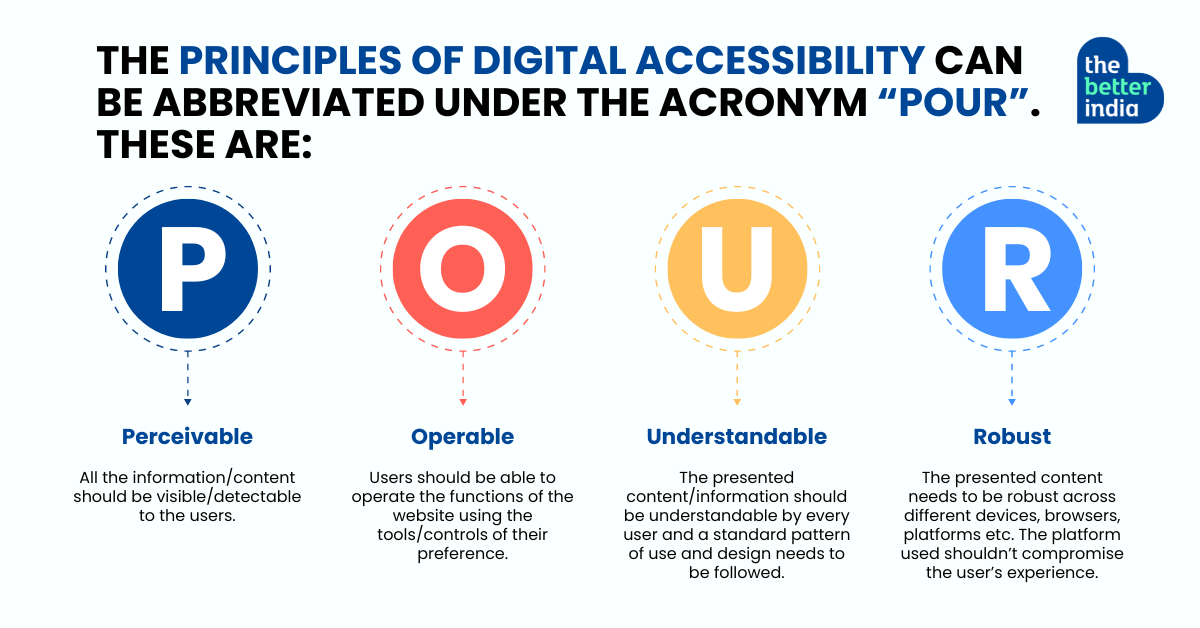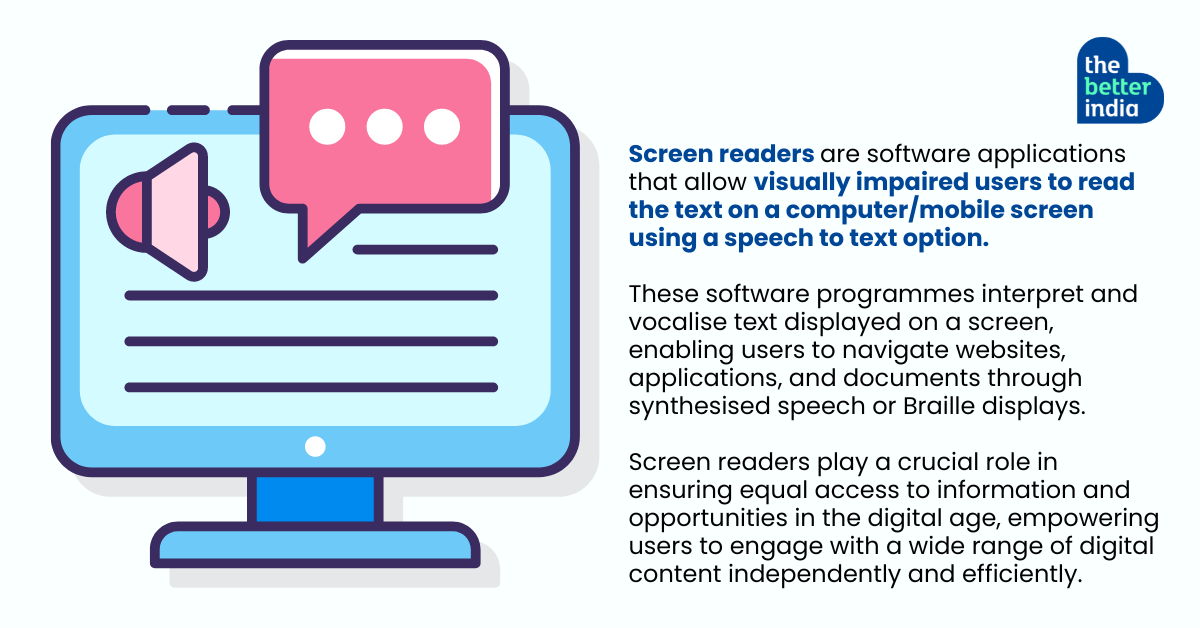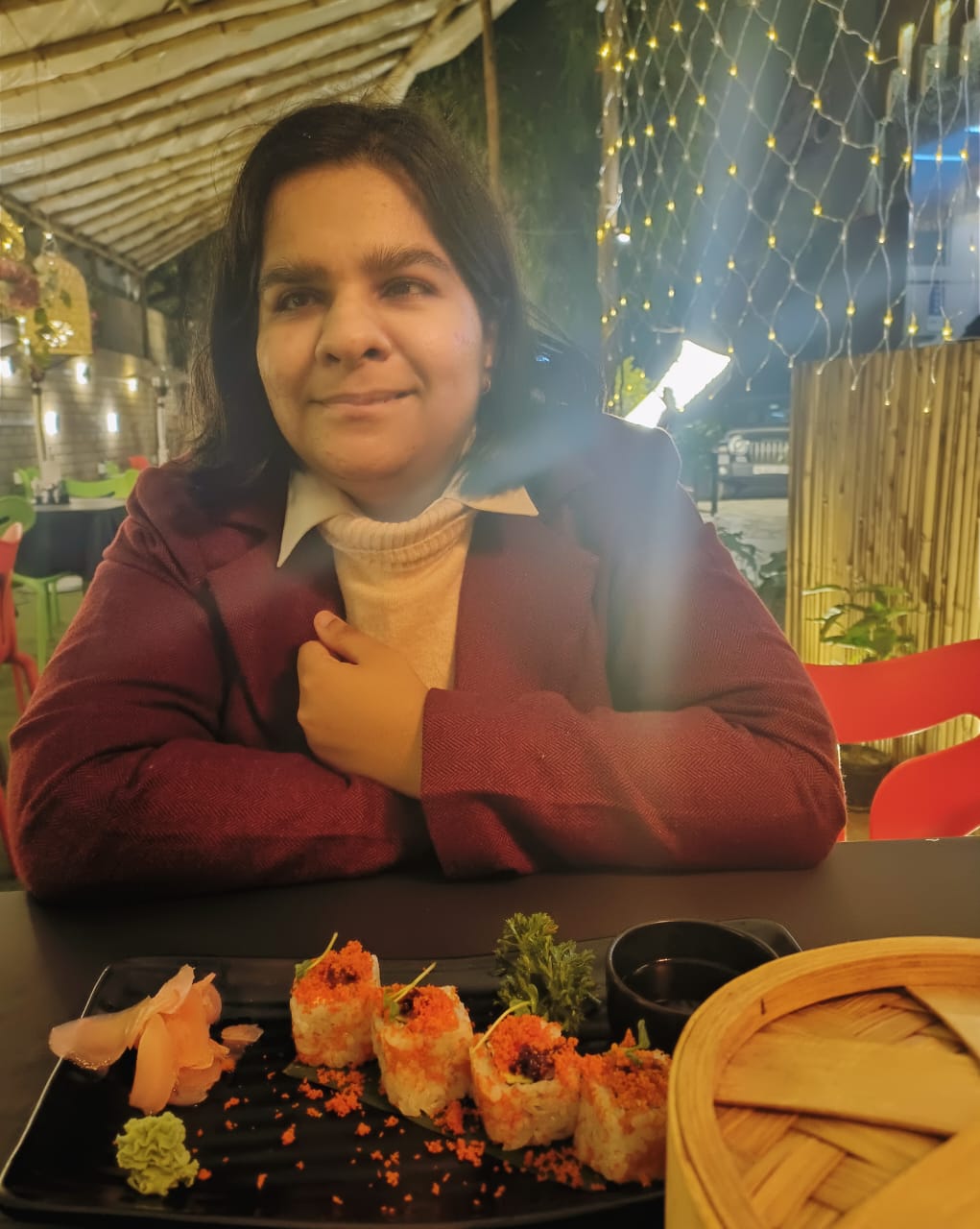“Once blindness takes over, it shatters your world and you don’t know what to do, where to go, especially after the doctor says that they can’t do anything at this point,” explains Anchal Bhateja when asked about how she coped after going completely blind as a school student.
Anchal was born with low vision due to complications at the time of her birth. While she was able to cope in a mainstream school till class 10, she completely lost her vision right before her board exams.
Following her diagnosis, Anchal had to chart out a path for herself on her own — from taking her exams with the assistance of a scribe to figuring out tools that would help her complete her education.
At this point, she met another blind person in her hometown, Bhatinda, who used computers with a screen reader. Anchal learned quite a bit from him and thus, her journey with digital accessibility devices began.
She completed her schooling by referring to audiobooks of her course and used a scribe to appear for the exams.
The Global Accessibility Day (GAAD) is celebrated on the third Thursday of May every year. The day strives to get the international community together to talk and build awareness about Digital Accessibility for disabled persons.
The mission for Digital Accessibility is spearheaded by WebAIM (Web Accessibility in Mind).
Through GAAD, impacted communities worldwide make the case for digital accessibility for diverse disabilities. There are approximately one billion Persons with Disability (PwD) in the world, and creating accessible digital technology is important from a civil rights as well as a business perspective.

Life after diagnosis
“I had to figure it out all on my own. Most people, including my father, initially felt that I would not be able to continue my education. Despite my father being educated, he still didn’t know what was the way forward for me. I don’t blame them, that’s what any lay person feels about blindness,” she says.
Determined to continue her education, Anchal appeared for the Common Law Admission Test (CLAT) and went on to become the first blind student to study at the National Law School of India University (NLSIU), Bengaluru.
With the admissions season upon us, every recent school graduate and their parents have been worried about the upcoming entrance exams.
Anchal’s story is also a reminder to each one of us about how this too shall pass. In spite of all the hurdles, Anchal completed law school in 2023 and is currently working as a lawyer at one of the top law firms in India.
However, her story doesn’t end with just clearing the CLAT Exams. In fact, that was the beginning in a number of ways.
As a first-year student, Anchal used to write her exams with the help of a scribe until her Legal Theory professor recommended she type out her answers.
Initially reluctant, Anchal took her laptop to the exam hall and began typing out her responses.
Surprisingly, she was able to finish it within 3 hours. There was no looking back after this. Anchal went on to take all her exams on her laptop without the assistance of a scribe. “I was always offered half an hour extra but I never needed it; I was always one of the first students to finish writing,” gleams Anchal.
“Now that I work in Telecom Media and Technology Law, my friends joke that my entire life is in virtual space. I use apps for grocery, for cabs, for everything!” she shares.
Newer technological innovations and services, especially app-based deliveries and services, have made independent living more accessible for several persons with disability.

Lack of digital infrastructure a major challenge
Not having the proper digital accessibility and awareness continues to pose a challenge. As per the latest Web Accessibility Report by WEBAIM, over 95% of the home pages of 1,000,000 most visited websites had accessibility issues.
This means that even if persons with disability have the appropriate tools and training, a number of web spaces remain inaccessible.
This has an impact on their work as well. In her work as a lawyer, Anchal has to access case judgments using online archives. However, websites that the courts accept don’t have accessibility built into them. As a result, Anchal often has to rely on someone else to help her navigate through these websites.
Other than this, Anchal mentions how even the IT staff is not fully aware of how a screen reader works and how it can be amalgamated with the softwares used at the workplace.
Anchal’s journey underscores the critical need for widespread accessibility awareness.
The Rights of Persons with Disability Act, 2016 mandates all institutions and workplaces to provide reasonable accommodation and accessible infrastructure. This includes offering accessible materials and resources and conducting regular accessibility audits to identify and address infrastructural barriers and providing training and support to employees with disabilities, along with conducting sensitisation programmes for other employees and people in the workplace or institution.
Law is a competitive and demanding profession which requires one to do a lot of reading and documentation. The general understanding so far has been that this would not be appropriate for a visually-impaired person.
However, digital innovations have made it possible for persons with disabilities to add to the diversity of the profession.

Inclusivity IRL
When asked about the disability inclusion journey at her organisation, Seema (name changed), a human resources manager based out of Delhi, says “Including persons with disabilities has helped the organisation in several unintended ways. Beyond just creating a more equitable workforce, having PwDs at the workplace has helped us relook at our policies, processes and infrastructure from a new perspective.”
As more and more employers warm up to the idea of employing lawyers with disabilities, the industry is also moving towards becoming a more inclusive space for all.
Echoing this sentiment, Amar Jain, a visually impaired lawyer and accessibility professional, says “As a lawyer with a disability, we face enormous barriers. The data provided by clients is not accessible, the physical case files don’t have digital copies. However, there are a number of progressive steps being taken by the judicial system.”
“For instance, the Delhi High Court recently released a mandate to provide digital copies of case files to lawyers with disabilities. The landscape is changing, slowly but surely,” he adds.
A little understanding can go a long way in such a situation. Anchal interned at Justice DY Chandrachud’s chambers as a student. She remembers how forthcoming they were with respect to offering ‘Reasonable Accommodations’ to help her work better.
“We need to make case briefs with page number references. As a visually-impaired person, it is sometimes difficult to find the right page number, so I use paragraph numbers instead and this request of mine was accommodated and helped me better do my work,” she explains.
Anchal also recollects how she received a letter from Justice Chandrachud upon completing the internship in his chamber.
“He told me that my research skills were remarkable and that he faced no challenges in using the briefs prepared by me. He was also an understanding senior as he was open to me working in my own way and using slightly different formats to present my briefs,” she shares.
Aanchal’s story is more than just an individual’s triumph over adversity, it is a powerful call to action for building a truly inclusive society. By promoting accessibility awareness and implementing robust support systems, we can empower everyone regardless of ability to reach their full potential.
Anchal’s journey is just one of the many. People with diverse disabilities benefit from digital accessibility. This can be found in a number of different forms. From adaptive keyboards to speech to text softwares, technology has come a long way in finding ways to accommodate human diversity, all that is remaining is a sincere effort from us to integrate it into our lives.
Written by V-shesh, edited by Padmashree Pande.
No comments:
Post a Comment